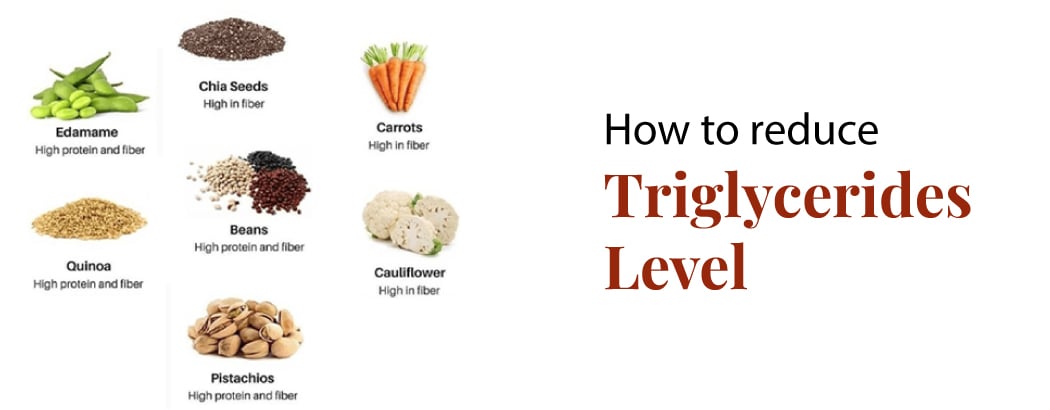How to reduce triglyceride levels?
April 30, 2024

Triglyceride levels
A crucial indicator of cardiac health is triglycerides. The risk of heart disease can be elevated by having high blood triglyceride levels. However, one can reduce triglycerides by adopting the same lifestyle choices that support general health.
Table of Contents
- What are triglycerides?
- High triglycerides: what causes them?
- What are the triglyceride levels in blood?
- Why are high triglycerides risky?
- What are ways to reduce high triglycerides?
- Conclusion
- Frequently Asked Questions
What are triglycerides?
One category of fat is triglycerides. They are an important source of energy in the diet and the main way that fats are stored. They can be found in foods that we eat, such as dairy products, meat, and cooking oils. Triglycerides are absorbed in the intestines during digestion and are then carried by the bloodstream to the tissues, where they are either deposited as fat or taken up by the cells and utilized as fuel. Many tissues, including the liver, stomach, muscle, and adipose tissues, have the capacity to synthesize triglycerides in addition to absorbing them from the diet.
The extra calories we consume are transformed by the liver into triglycerides, which are then held in our adipose (fat) cells until we need them. Triglycerides are released under the control of hormones.
Although our body uses triglycerides as an energy source, having too much of them in our blood can raise the risk of heart disease.
High triglycerides: what causes them?
There are several reasons why triglyceride levels may be higher than normal. A few among them are:
- Consuming foods heavy in fat or sugar regularly
- A body mass index (BMI) of 25 or greater
- Not exercising enough
- Using tobacco
- Consuming a lot of booze
- Possessing a hereditary condition influencing the way your body breaks down fats
- Thyroid conditions
- Diabetes type 2 that is poorly managed
- Renal or liver problems
- Some medications, such as corticosteroids, beta-blockers, and hormones
What are the triglyceride levels in blood?
The following is the comparison of triglyceride test results:
- Less than 150 mg/dL is normal.(mg/dL =milligrams per deciliter)
- 150–199 mg/dL is borderline.
- 200–499 mg/dL is high.
- 500 mg/dL and higher is extremely high.
Why are high triglycerides risky?
Increased risk of heart disease, stroke, and heart attack is associated with arteriosclerosis, a hardening of the arteries, or thickening of the arterial walls caused by high triglycerides. Pancreatitis, or acute inflammation of the pancreas, can also be brought on by abnormally high triglycerides.
Excessive triglycerides frequently indicate other conditions that raise the risk of heart disease and stroke, such as obesity and metabolic syndrome, a group of ailments that include high blood pressure, high triglycerides, abnormal cholesterol levels, and excess body fat around the waist.
What are ways to reduce high triglycerides?
Lowered triglyceride levels, improved cholesterol, and a reduced risk of heart disease can all be achieved with a healthy diet and exercise regimen. Following are some of the ways to reduce triglycerides:
FIBRE RICH DIET – Consuming a diet rich in fibre daily can aid in lowering blood pressure, cholesterol, blood sugar, triglycerides, and weight. Adding foods high in fibre to your diet can help, such as legumes, lentils, oats (preferably sugar-free), green veggies, whole wheat crackers, brown rice, etc.
LOW CARB DIET: Another method to help lower triglyceride levels is to avoid refined carbohydrates and sweets. For example, reducing table sugar, white rice, white flour, potatoes, and other starchy vegetables and foods in packages that have high fructose corn syrup can help reduce triglycerides.
EAT LESS RED MEAT: Triglycerides can be elevated by foods high in saturated fat, including red meat. Try incorporating more vegetables and meatless dinners in your diet. Select lean meats with less saturated fat, such as chicken and unprocessed turkey.
MODERATE EXERCISE: Engage in a modest workout. Aim to work out five or more days a week. Your body finds it more difficult to metabolise triglycerides and blood sugar while you are immobile. It is therefore imperative that you get up and move about as much as you can.
MAINTAIN BODY WEIGHT: Pay attention to your weight. Lowering your weight will help lower your triglycerides if you’re carrying extra weight. Normal levels are more common in those who weigh a healthy amount.
MINIMISE ALCOHOL INTAKE: Spirits, beer, and wine can elevate levels. Try and limit your alcohol consumption to maintain triglyceride levels.
DRINK MORE WATER: Sugar and fructose – which are used as sweeteners in soda, sweet tea, and fruit juices – can raise triglycerides. The extra calories in sugary drinks can also make you gain weight, which puts added strain on your heart.
PORTION SIZE CONTROL: Make sure the portion size is correct. Eating excessively large meals can raise your triglyceride levels, which raises the possibility of a heart attack. Halve the portion that you normally serve.
AVOID SKIPPING MEALS: Avoid skipping meals, even if you’re too busy to eat. your triglyceride levels rise as a result of overindulging at the following meal. Eating modestly sized meals several times a day is preferable.
NO SMOKING: Give up smoking. Your risk of heart disease rises sharply if you smoke.
Conclusion
Our triglyceride levels can be significantly impacted by dietary and lifestyle choices.
There are several ways to lower blood triglycerides, including eating more healthy, unsaturated fats rather than trans fats, cutting back on carbohydrates and added sugars, and engaging in regular exercise.
One can simultaneously lower triglycerides and enhance general health by making a few lifestyle changes.
Frequently Asked Questions
1. How can I determine whether my triglycerides are elevated?
Elevated triglycerides can be detected with a basic blood test. Additionally, your doctor might search for linked health issues. Diabetes, obesity, a sluggish thyroid gland, and kidney illness are a few of these health issues.
2. How do triglycerides and cholesterol differ from one another?
Different forms of lipids that circulate in your blood include cholesterol and triglycerides. Your body stores excess energy in the form of triglycerides. Cells and several hormones are made with cholesterol.
4. Will I be prescribed any medication for high triglycerides?
Your doctor may suggest medicines if making healthy lifestyle adjustments isn’t enough to lower high triglycerides.







